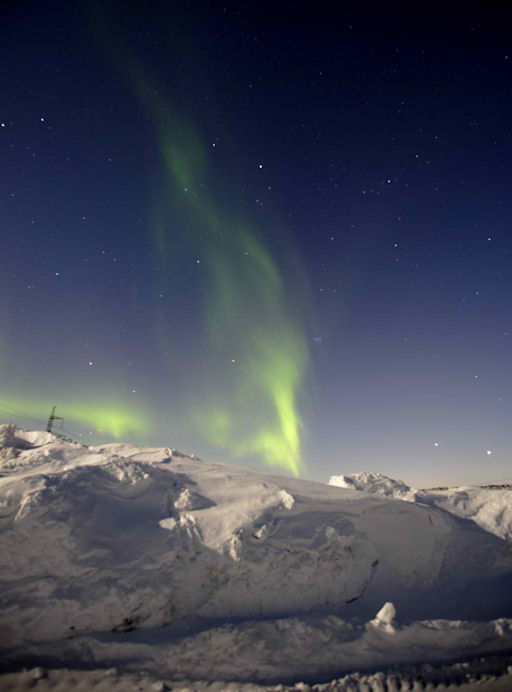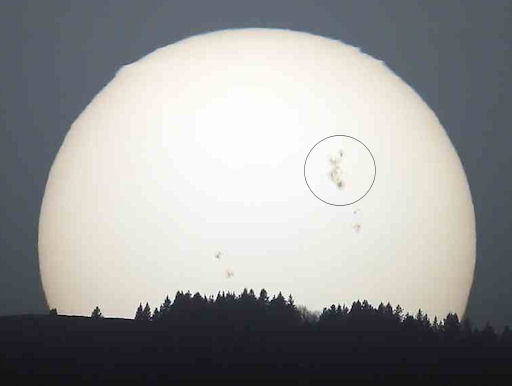CME IMPACT: A coronal mass ejection (CME) hit Earth's magnetic field on March 8th around 1100 UT. The impact was weaker than expected, sparking only a mild (Kp=5) geomagnetic storm. However, the storm could intensify in the hours ahead depending on electromagnetic conditions in the wake of the CME. High-latitude sky watchers should be alert for auroras. Aurora alerts: text, phone.
Giovanni Cappelli sends this picture from the tundra east of Murmansk, Russia:
"We were in the tundra waiting for the CME," says Cappelli. "The auroras were better than expected this time. This photo resembled green fire shooting up from the snow "
more images: from Pavel Kantsurov of Norilsk, Russia; from Aleksander Chernucho of Kola peninsula, Russia, Mt. Khibiny; from Chad Blakley of Aurora Sky Station, Abisko National Park, Sweden; from Timo Newton-Syms of Ruka, Finland; from Timo Veijalainen of Sodankylä, Finland;
HUGE SUNSPOT: Active sunspot AR1429 continues to grow. It is now more than seven times wider than Earth, which makes it an easy target for backyard solar telescopes. In fact, yesterday, David Tremblay of Alto, New Mexico, saw it using no telescope at all. All he needed was a dust storm:
"The dust blowing from Tularosa Basin was so dense, we could observe the sun with the naked eye--and there was sunspot AR1429. Wow!" says Tremblay.
The behemoth spot has unleashed four strong flares since it emerged on March 2nd, including the X5-class eruption of March 7th. More could be in the offing. The active region has a "beta-gamma-delta" class magnetic field that harbors energy for additional X-class eruptions. Solar flare alerts: text, phone.
more images: from Jett Aguilar of Quezon City, Philippines; from James Kevin Ty of Manila, Philippines; from Harald Paleske of Langendorf b. Weißenfels, Germany; from Rogerio Marcon of Campinas SP Brasil; from Monika Landy-Gyebnar of Veszprem, Hungary; from Ron Wayman of Tampa Florida; from John Stetson of Falmouth, Maine; from Robert Lowton of Whaley Bridge, Peak District, United Kingdom; from José Geraldo Mattos of Florianópolis, Jurerê Internacional, Santa Catarina, Brasil; from Matthew Wastell of Brisbane, Australia; from Kiss Csongor of Derecske, Hungary

![]()
Solar wind
speed: 290.8 km/sec
density: 4.6 protons/cm3
explanation | more data
Updated: Today at 1805 UT
![]()
X-ray Solar Flares
6-hr max: C1 1623 UT Mar08
24-hr: C7 0253 UT Mar08
explanation | more data
Updated: Today at: 1800 UT
![]()
![]()
![]()
Daily Sun: 08 Mar 12
![]()
![]()
Big sunspot 1429 poses a continued threat for X-class solar flares. Credit: SDO/HMI
![]()
![]()
![]()
Sunspot number: 102
What is the sunspot number?
Updated 07 Mar 2012
Spotless Days
Current Stretch: 0 days
2012 total: 0 days (0%)
2011 total: 2 days (<1%)
2010 total: 51 days (14%)
2009 total: 260 days (71%)
Since 2004: 821 days
Typical Solar Min: 486 days
Updated 07 Mar 2012
The Radio Sun
10.7 cm flux: 136 sfu
explanation | more data
Updated 07 Mar 2012
![]()
![]()
![]()
Current Auroral Oval:
![]()
Switch to: Europe, USA, New Zealand, Antarctica
Credit: NOAA/POES
![]()
![]()
![]()
Planetary K-index
Now: Kp= 5 storm
24-hr max: Kp= 5 storm
explanation | more data
![]()
Interplanetary Mag. Field
Btotal: 11.1 nT
Bz: 0.9 nT south
explanation | more data
Updated: Today at 1817 UT
![]()
![]()
![]()
Coronal Holes: 08 Mar 12
![]()
![]()
A solar wind stream flowing from this coronal hole could reach Earth as early as March 9-10. Credit: SDO/AIA.






